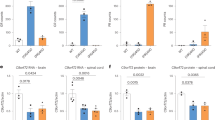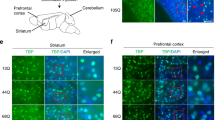Abstract
The expansion of an unstable CAG repeat causes spinocerebellar ataxia type 1 (SCA1) and several other neurodegenerative diseases. How polyglutamine expansions render the resulting proteins toxic to neurons, however, remains elusive. Hypothesizing that long polyglutamine tracts alter gene expression, we found certain neuronal genes involved in signal transduction and calcium homeostasis sequentially downregulated in SCA1 mice. These genes were abundant in Purkinje cells, the primary site of SCA1 pathogenesis; moreover, their downregulation was mediated by expanded ataxin-1 and occured before detectable pathology. Similar downregulation occurred in SCA1 human tissues. Altered gene expression may be the earliest mediator of polyglutamine toxicity.
This is a preview of subscription content, access via your institution
Access options
Subscribe to this journal
Receive 12 print issues and online access
$209.00 per year
only $17.42 per issue
Buy this article
- Purchase on Springer Link
- Instant access to full article PDF
Prices may be subject to local taxes which are calculated during checkout






Similar content being viewed by others
References
Zoghbi, H. Y. & Orr, H. T. Spinocerebellar ataxia type 1. Seminars in Cell Biology: Unstable Repeat Diseases Vol. 6, 29–35 (Saunders, Philadelphia, 1995 ).
Matilla, A. et al. Mice lacking ataxin-1 display learning deficits and decreased hippocampal paired-pulse facilitation. J. Neurosci. 18, 5508–5516 (1998).
Burright, E. N. et al. SCA1 transgenic mice: a model for neurodegeneration caused by an expanded CAG trinucleotide repeat. Cell 82, 937–948 (1995).
Clark, H. B. et al. Purkinje cell expression of a mutant allele of SCA1 in transgenic mice leads to disparate effects on motor behaviors, followed by a progressive cerebellar dysfunction and histological alterations. J. Neurosci. 17, 7385–7395 (1997).
Skinner, P. J. et al. Ataxin-1 with extra glutamines induces alterations in nuclear matrix-associated structures. Nature 389, 971–974 (1997).
Klement, I. A. et al. Ataxin-1 nuclear localization and aggregation: Role in polyglutamine-induced disease in SCA1 transgenic mice. Cell 95, 41–53 (1998).
Dai, Q. et al. Mammalian prenylcysteine carboxyl methyltransferase is in the endoplasmic reticulum. J. Biol. Chem. 273, 15030– 15034 (1998).
Imai, Y., Davey, J., Kawagishi-Kobayashi, M. & Yamamoto, M. Genes encoding farnesyl cysteine carboxyl methyltransferase in Schizosaccharomyces pombe and Xenopus laevis. Mol. Cell. Biol. 17, 1543–1551 (1997).
Mitchell, C. A., Brown, S., Campbell, J. K., Munday, A. D. & Speed, C. J. Regulation of second messengers by the inositol polyphosphate 5-phosphatases. Biochem. Soc. Trans. 24, 994–1000 ( 1996).
Mori, Y. et al. Differential distribution of TRP Ca2+ channel isoforms in mouse brain. Neuroreport 9, 507–515 (1998).
Yamada, K. et al. EAAT4 is a post-synaptic glutamate transporter at Purkinje cell synapses. Neuroreport 7, 2013– 2017 (1996).
Mailleux, P., Takazawa, K., Erneux, C. & Vanderhaeghen, J. J. Comparison of neuronal inositol 1,4,5-trisphosphate 3-kinase and receptor mRNA distributions in the adult rat brain using in situ hybridization histochemistry. Neuroscience 49, 577–590 (1992).
Kotera, J. et al. Expression of rat cGMP-binding cGMP-specific phosphodiesterase mRNA in Purkinje cell layers during postnatal neuronal development. Eur. J. Biochem. 249, 434–442 (1997).
Roustan, P. et al. The rat phospholipase C beta 4 gene is expressed at high abundance in cerebellar Purkinje cells. Neuroreport 6, 1837–1841 (1995).
Inglis, J. D., Lee, M., Davidson, D. R. & Hill, R. E. Isolation of two cDNAs encoding novel alpha 1-antichymotrypsin-like proteins in a murine chondrocytic cell line. Gene 106, 213– 220 (1991).
Akaaboune, M., Ma, J., Festoff, B. W., Greenberg, B. D. & Hantai, D. Neurotrophic regulation of mouse muscle beta-amyloid protein precursor and alpha 1-antichymotrypsin as revealed by axotomy. J. Neurobiol. 25, 503–514 (1994).
Jiang, Y. H. et al. Mutation of the Angelman ubiquitin ligase in mice causes increased cytoplasmic p53 and deficits of contextual learning and long-term potentiation . Neuron 21, 799–811 (1998).
Abraham, C. R., Selkoe, D. J. & Potter, H. Immunochemical identification of the serine protease inhibitor alpha 1-antichymotrypsin in the brain amyloid deposits of Alzheimer's disease. Cell 52, 487–501 (1988).
Das, S. & Potter, H. Expression of the Alzheimer amyloid-promoting factor antichymotrypsin is induced in human astrocytes by IL-1. Neuron 14, 447–456 ( 1995).
Koo, E. H., Abraham, C. R., Potter, H., Cork, L. C. & Price, D. L. Developmental expression of alpha 1-antichymotrypsin in brain may be related to astrogliosis. Neurobiol. Aging 12, 495–501 ( 1991).
Tanaka, J., Ichikawa, R., Watanabe, M., Tanaka, K. & Inoue, Y. Extra-junctional localization of glutamate transporter EAAT4 at excitatory Purkinje cell synapses. Neuroreport 8, 2461–2464 ( 1997).
Birnbaumer, L. et al. On the molecular basis and regulation of cellular capacitative calcium entry: roles for Trp proteins. Proc. Natl. Acad. Sci. USA 93, 15195–15202 ( 1996).
Zhu, X. et al. trp, a novel mammalian gene family essential for agonist-activated capacitative Ca2+ entry. Cell 85, 661–671 (1996).
Drayer, A. L. et al. The family of inositol and phosphatidylinositol polyphosphate 5-phosphatases. Biochem. Soc. Trans. 24, 1001–1005 (1996).
Woscholski, R. & Parker, P. J. Inositol lipid 5-phosphatases—traffic signals and signal traffic. Trends Biochem. Sci. 22, 427–431 (1997).
De Smedt, F., Verjans, B., Mailleux, P. & Erneux, C. Cloning and expression of human brain type I inositol 1,4,5-trisphosphate 5-phosphatase. High levels of mRNA in cerebellar Purkinje cells. FEBS Lett. 347, 69–72 ( 1994).
Takei, K., et al. Ca2+ stores in Purkinje neurons: endoplasmic reticulum subcompartments demonstrated by the heterogeneous distribution of the InsP3 receptor, Ca2+-ATPase, and calsequestrin. J. Neurosci. 12, 489–505 (1992).
Villa, A. et al. The endoplasmic reticulum of Purkinje neuron body and dendrites: molecular identity and specializations for Ca2+ transport. Neuroscience 49, 467–477 (1992).
Volpe, P., Nori, A., Martini, A., Sacchetto, R. & Villa, A. Multiple/heterogeneous Ca2+ stores in cerebellum Purkinje neurons. Comp. Biochem. Physiol. Comp. Physiol. 105, 205–211 ( 1993).
Matsumoto, M. et al. Ataxia and epileptic seizures in mice lacking type 1 inositol 1,4,5-trisphosphate receptor. Nature 379, 168–171 (1996).
Street, V. A. et al. The type 1 inositol 1,4,5-trisphosphate receptor gene is altered in the opisthotonos mouse. J. Neurosci. 17, 635–645 (1997).
Miller, K. K., Verma, A., Snyder, S. H. & Ross, C. A. Localization of an endoplasmic reticulum calcium ATPase mRNA in rat brain by in situ hybridization . Neuroscience 43, 1–9 (1991).
Nakanishi, S., Maeda, N. & Mikoshiba, K. Immunohistochemical localization of an inositol 1,4,5-trisphosphate receptor, P400, in neural tissue: studies in developing and adult mouse brain . J. Neurosci. 11, 2075– 2086 (1991).
Ross, C. A., Danoff, S. K., Schell, M. J., Snyder, S. H. & Ullrich, A. Three additional inositol 1,4,5-trisphosphate receptors: molecular cloning and differential localization in brain and peripheral tissues. Proc. Natl. Acad. Sci. USA 89, 4265–4269 (1992).
Berridge, M. J. Neuronal calcium signaling. Neuron 21, 13 –26 (1998).
Verkhratsky, A. & Toescu, E. C. Calcium and neuronal aging. Trends Neurosci. 21, 2– 7 (1998).
Liu, B. F., Xu, X., Fridman, R., Muallem, S. & Kuo, T. H. Consequences of functional expression of the plasma membrane Ca2+pump isoform 1a. J. Biol. Chem. 271, 5536–5544 (1996).
Rando, R. R. Chemical biology of protein isoprenylation/methylation. Biochim. Biophys. Acta 1300, 5–16 (1996).
Clarke, S. Protein isoprenylation and methylation at carboxyl-terminal cysteine residues . Annu. Rev. Biochem. 61, 355– 386 (1992).
Hrycyna, C. A. & Clarke, S. Modification of eukaryotic signaling proteins by C-terminal methylation reactions. Pharmacol. Ther. 59, 281–300 (1993).
Choy, E., et al. Endomembrane trafficking of ras: the CAAX motif targets proteins to the ER and Golgi. Cell 98, 69– 80 (1999).
Cummings, C. J. et al. Chaperone suppression of aggregation and altered subcellular proteasome localization imply protein misfolding in SCA1. Nat. Genet. 19, 148–154 ( 1998).
Ciechanover, A. The ubiquitin-proteasome proteolytic pathway. Cell 79, 13–21 (1994).
Masuyama, H. & MacDonald, P. N. Proteasome-mediated degradation of the vitamin D receptor (VDR) and a putative role for SUG1 interaction with the AF-2 domain of VDR. J. Cell. Biochem. 71, 429–440 (1998).
Nawaz, Z., Lonard, D. M., Dennis, A. P., Smith, C. L. & O'Malley, B. W. Proteasome-dependent degradation of the human estrogen receptor. Proc. Natl. Acad. Sci. USA 96, 1858–1862 (1999).
Zhang, J., Guenther, M. G., Carthew, R. W. & Lazar, M. A. Proteasomal regulation of nuclear receptor corepressor-mediated repression . Genes Dev. 12, 1775–1780 (1998).
Doucas, V., Tini, M., Egan, D. A. & Evans, R. M. Modulation of CREB binding protein function by the promyelocytic (PML) oncoprotein suggests a role for nuclear bodies in hormone signaling. Proc. Natl. Acad . Sci. USA 96, 2627–2632 (1999).
Acknowledgements
The authors thank A. Beaudet for providing the Ube3a null mice, M. Philips at New York University School of Medicine and K. Tanaka at the National Institute of Neuroscience in Japan for providing the anti-PCCMT and anti-EAAT4 antibodies, H. J. Bellen for reading the manuscript and V. Brandt for comments. This work was supported by grants NS27699 and NS22920 from the National Institutes of Health (to H.Y.Z. and H.T.O.) and by the core facilities of the Baylor College of Medicine Mental Retardation Research Center. X. Lin is an Associate and H. Zoghbi an Investigator with the Howard Hughes Medical Institute.
Author information
Authors and Affiliations
Corresponding author
Rights and permissions
About this article
Cite this article
Lin, X., Antalffy, B., Kang, D. et al. Polyglutamine expansion down-regulates specific neuronal genes before pathologic changes in SCA1. Nat Neurosci 3, 157–163 (2000). https://doi.org/10.1038/72101
Received:
Accepted:
Issue Date:
DOI: https://doi.org/10.1038/72101
This article is cited by
-
Radiological hints for differentiation of cerebellar multiple system atrophy from spinocerebellar ataxia
Scientific Reports (2022)
-
Investigation of the Influence of TBP CAG/CAA Repeats in Conjunction with HTT CAG Repeats on Huntington’s Disease Age at Onset in a Brazilian Sample
Journal of Molecular Neuroscience (2022)
-
Impact of Reduced Cerebellar EAAT Expression on Purkinje Cell Firing Pattern of NPC1-deficient Mice
Scientific Reports (2018)
-
Developmental YAPdeltaC determines adult pathology in a model of spinocerebellar ataxia type 1
Nature Communications (2017)



